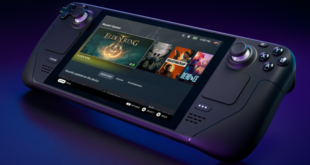PC GAMING WEEK: Valve has been transforming the PC gaming marketplace.
While the firm hasn’t been making – or at least releasing – third installments in its highly popular game franchises, it has been busy taking over PC retail with its Steam store. In October 2013 it was estimated that 75 per cent of all digital downloads were through the firm’s outlet with over 75m accounts registered on Steam.
Now Valve wants to bring PC gaming to the living room and has approached a number of big hardware companies in the PC gaming sphere to help them achieve this goal. So what has kept PC gaming outside of the living room for this long? There are three key factors to this – all of which Valve has tackled with the Steam Machine, Controller and OS.
STREAMLINING PC GAMING
The primary reason was that the boxes themselves were not suitable for a living room environment – both because they were cumbersome and loud, and as a result of the lack of the ‘plug and play’ instant gratification that some gamers have come to expect with consoles.
Machines have to fit in and work within a customer’s existing home theatre ecosystem,” explains Wallace Santos – founder and CEO of MainGear, which is building a Steam Machine called Spark.
They also have to be cool, quiet, and deliver enough power to drive 1080p resolutions at 60fps. Previously, you could choose two of those three things, but now we can deliver on each of them.
Swedish hardware firm Webhallen’s purchasing manager Anton Nilsson adds: One of the problems has been the design, price and performance of PCs catering to the living room.”
Another issue has been the software. PC gaming – when compared to consoles – is high maintenance. A game needs to be installed, before the player checks that they have all the software to play it. Stephane Guyard, business unit manager at French hardware company Materiel.net explains: Dealing with drivers and so on is too complicated for many people.”
John Woodward, Zotac’s North European regional manager agrees: With Steam OS and Steam Machines, we’re making PC gaming mainstream so anyone can just buy a system, hook it up and start gaming.”
TECHNICAL DIFFICULTIES
Indeed, attaching a PC to a TV is not as simple as it sounds, says Alienware marketing director Bryan Dezayas. If you attached a computer to a TV there are some technical challenges like trying to figure out the overscan settings are,” he says.
The Steam OS is designed to eradicate these problems, distilling the experience down to a clear and easy to use system, similar to what we have come to expect from consoles. The design has been derived from the user interfaces used in the likes of Xbox and PlayStation.
There was a need for a different UI at ten-feet away when you’re sitting on your couch versus three-feet away when you’re sitting at your desk,” says Santos.
The final issue is one of control. Most PC gamers prefer a to use a mouse and keyboard; a set-up which is not suited for a living room console experience – yet PC gamers feel traditional gamepads do not offer the same precision.
CONTROL ISSUES
The Steam controller promises to resolve this issue, aiming to replace the mouse and keyboard that PC games are built around.
With the new Steam controller, we’re going to see even more precision and control available to gamers that are used to using their keyboard and mouse,” says Maingear’s Santos.
Origin PC CEO Kevin Wasielewski concurs: The controller provides a console gaming experience and keyboard-mouse functionality.”
The controller replaces the analogue sticks found on a traditional gamepad with two trackpads which provide haptic feedback. In addition, there are face buttons which can be mapped as the player sees fit.
You’re not going to want to type out an essay or anything with the controller but it’s fine if you’re looking to chat with a friend,” Dezayas explains.
So the Steam Machine is trying to streamline the PC gaming experience with a plug in and play mentality. But not only that, it does something that even the most recent consoles can’t boast – it allows you to play your old games.
Where the Xbox One and PS4 launched with a handful of titles – and are no backwards compatibility – the Steam Machine allows gamers access to their entire back catalogue.
If you bought the games under a Windows licence, that will carry over onto the Steam OS,” explains Dezayas.
Not only this – the entire Steam store is there, with thousands of games to choose from.
Players can access a large variety of games through Steam that includes anything ranging from blockbusters to indie titles,” explains Woodward.
What the Steam Machine offers – on top of the streamlining of the PC gaming experience – is choice. Players cannot only map the controller how they please, but they also have a number of products to choose from. There are 14 companies building Steam Machines now, and this number is only set to grow.
Not only is the choice great for gamers who want a Steam Machine that is suited to them, but also because companies will be competing to be the best.
Competition is important. It helps. drive innovation and moves the industry forward,” says Wasielewski.
But there is still one huge challenge that this new hardware must overcome – high costs. The cheapest Steam Machine is CyberpowerPC’s device at $499, and this rises to $6,000 for Falcon Northwest’s Tiki.
So it remains to be seen if people will pay these premium prices to play PC games in their living room.

 MCV/DEVELOP News, events, research and jobs from the games industry
MCV/DEVELOP News, events, research and jobs from the games industry



